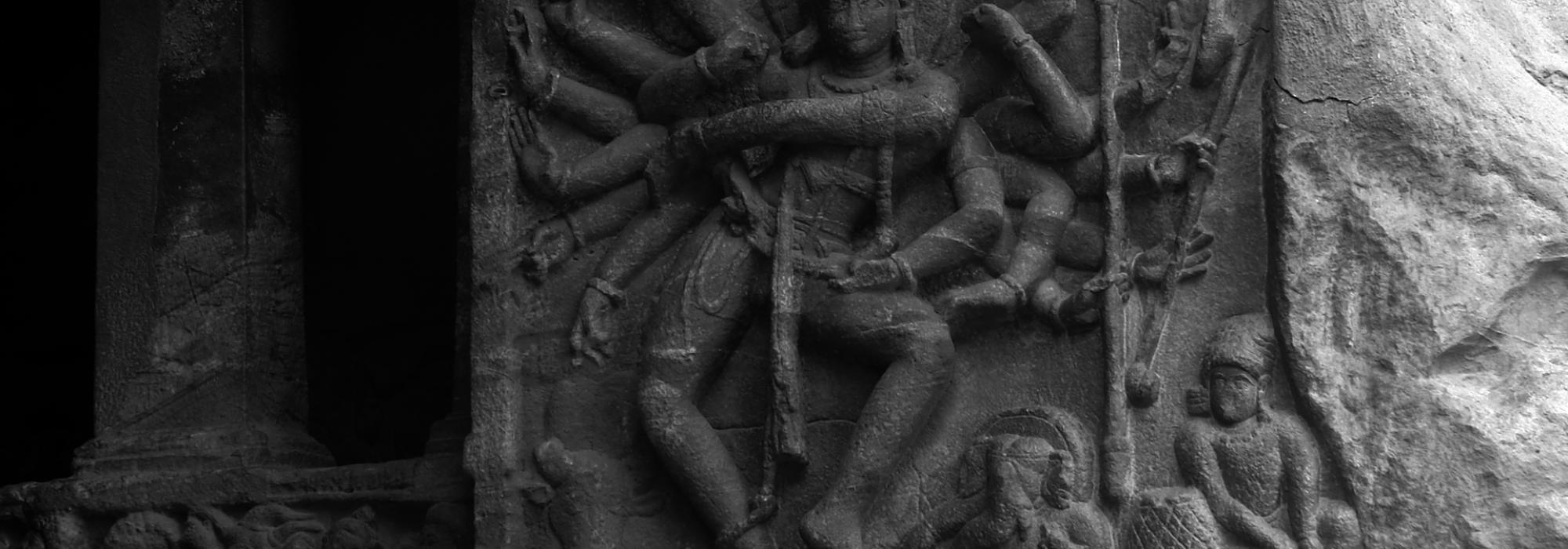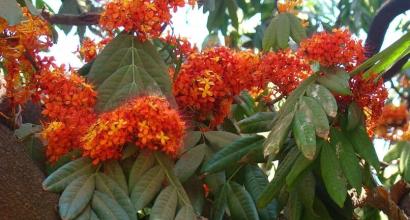The Nāṭyaśāstra is the world's oldest treatise on performing arts. It is more than 2,500 years old. This encyclopedic work on art by Bharata muni is divided into 36 chapters and contains more than 6,000 verses. The first chapter of the Nāṭyaśāstra gives a semi-historical and purāṇic account of the creation of the work. Bharata narrates it thus:
At the end of the kṛtayuga and at the on-set of the Tretāyuga, people on earth got addicted to base sentiments (ग्राम्य-धर्म) such as excessive desire, greed, jealousy, and anger and found their state of happiness mixed with sorrow. So the devas, with Indra leading them, approached Brahma (the deity of creation) and requested for audio-visual entertainment (क्रीडनीयकमिच्छामो दृश्यं श्रव्यं च यद्भवेत्). They also requested that this be made accessible to all people from all places. This indeed is the need of all people of all times – respite from the world which is filled with conflicting emotions.
The following five verses speak about the creation of Nāṭyaśāstra by Brahma:
धर्म्यमर्थ्यं यशस्यं च सोपदेश्यं ससङ्ग्रहम् ।
भविष्यतश्च लोकस्य सर्वकर्मानुदर्शकम् ॥
"It will contain good counsel for people in their pursuits of dharma, material needs, and fame. It will guide the world in the future too in all their endeavors."सर्वशास्त्रार्थसंपन्नं सर्वशिल्पप्रवर्तकम् ।
नाट्याख्यं पञ्चमवेदं सेतिहासं करोम्यहम् ॥
"It will contain the essence of all the śāstra-s and will be the foundation for all arts. I shall create Nāṭyaveda, the fifth Veda along with the itihāsas."एवं सङ्कल्प्य भगवान् सर्ववेदाननुस्मरन् ।
नाट्यवेदं ततश्चक्रे चतुर्वेदाङ्गसम्भवम् ॥
Having taken a decision thus, the deity recalled all the Vedas and created the Nāṭyaveda, which is born out of the four Vedasजग्राह पाठ्यमृग्वेदात्सामभ्यो गीतमेव च।
यजुर्वेदादभिनयान् रसानाथर्वणादपि ॥
He took the lyrics (पाठ्य) from the Ṛgveda, the music (गीत) from the Sāmaveda, the language of gestures (अभिनय) from the Yajurveda and the aesthetic experience (रस) from Atharvavedaवेदोपवेदैः सम्बद्धो नाट्यवेदो महात्मना ।
एवं भगवता सृष्टो ब्रह्मणा सर्ववेदिना ॥
Nāṭyaveda, which is closely linked to the Vedas and the Upavedas was thus created by the all-knowing Brahma, the omniscient
This episode establishes a context for the creation of the Nāṭyaśāstra and shouldn’t be taken literally. However, it shows that the creation of such a great treatise was an outcome of combining different theoretical and artistic mediums. The Nāṭyaśāstra is just a new form given to different disciplines that already existed – old wine in a new bottle. As is the case with most Indian śāstra-s, Bharata’s Nāṭyaśāstra is a descriptive work on the art forms which existed during his times. The art-forms were neither ‘created’ by Bharata nor does he prescribe a set of rules which need to be followed for all times and places. He even suggests in that the art forms must dynamically adapt to the tastes of people of different places and at different times. This is evident in the several deśi art forms which have evolved with regional variations based on the mārga set by Bharata.
The structural aspects of form such as lyrics, music and the language of gestures which are required to communicate the content to evoke an aesthetic experience (rasa) are all dealt with in detail in the Nāṭyaśāstra, i.e., it caters to both form and content. Moreover, it guarantees the fulfillment of the four-fold aspects of human-pursuit, i.e., the puruṣārtha–s धर्म, अर्थ, and काम, and also gives us a glimpse of the experience of Bliss (मोक्ष).
Brahma then asks Indra to instruct the devas to bring the Nāṭyaśāstra into practice. He adds that the Nāṭyaveda must only be passed on to those who are skillful, learned, mature, and willing to work hard. These indeed are the qualities which are to be expected of people who would like to study and practice the Nāṭyaśāstra even to this day. Indra finds the devas incapable of comprehending, assimilating, and practicing the art and feels that the sages who are well-versed in the Vedas are the ones who would be capable to do so. Brahma then instructs Bharata in the Nāṭyaveda and gives the responsibility to him and his hundred sons to propagate and practice the same. Bharata teaches his sons and assigns different roles to them.
Bharata created the three dramatic styles (वृत्ति) – the verbal (भारती), the subtle (सात्त्वती) and the energetic (आरभटी) and informed Brahma of his work. Brahma then suggested that he pick up the graceful style (कैशिकी-वृत्ति) from the dance of Śiva, which is made up of aṅgahāra-s and filled with bhāva and rasa. As this style could not be effectively practiced by humans alone, Brahma created apsaras, the celestial damsels from his mind, who were skillful in embellishing drama and he told them to assist Bharata. He assigned Svāti and his disciples to play on musical instruments and gandharvas such as Nārada to sing songs. Thus was the art of nātya created out of the existing art forms. The antiquity of the art forms can also be perceived as it is said that major deities such as Shiva and the devas were well-versed in them. The major deities and the Vedas are thought to have existed from times immemorial according to sanātana-dharma.
Brahma suggested to Bharata that the Indra-dhvajotsava, the festival in the honor of Indra’s killing of demons, would be a suitable occasion to put together a performance employing the principles of the Nāṭyaśāstra. Bharata begins the performance with the नान्दि, an auspicious benediction and devises to portray the popular episode of the samudra-mathana where the daityas (demons) were subdued by the devas (deities). The devas, pleased with the performance give rewards to Bharata. Indra gives him his auspicious banner and Brahma, a kuṭilaka (a curved stick to be used by the vidūṣaka, the clown). Varuṇa, the deity of water and cosmic order gives him a golden pitcher, suitable to drink water with. Sūrya, the sun deity gives him an umbrella, which gives shade from the sun. Vāyu, the deity of wind, gives him a fan. Śiva, as his very name suggests, rewards him with success. Viṣṇu rewards him with a lion-seat. Sarasvatī grants him competence for visual arts.
The daityas (mainly the vighnas), who were also audience to the staging of the play by Bharata, took it too realistically and forgetting that it is was merely an artistic portrayal of a historic event, they disrupted the play. Angered by this, Indra hurled his flag-staff at the daityas and smashed their assault. Since then, the flag-staff is called the ‘jarjara,’ deriving from the Sanskrit word for ‘smashed’, ‘जर्जरीकृतं.’ The mythical staff is even to this day used in its modified form by actors and is worshiped before a traditional stage-play, with the belief that it wards off evil (vighna).
Through this episode, Bharata subtly cautions connoisseurs about their responsibility of having a detached attitude while witnessing a play or any work of art in general. Emotional over-involvement and extrapolation of the incidents to everyday life will cause harm to both the art and the connoisseurs. More philosophically, when the bhavas do not get elevated to the level of rasa in a connoisseur’s mind due to his lack of maturity, art cannot be enjoyed.







































Comments